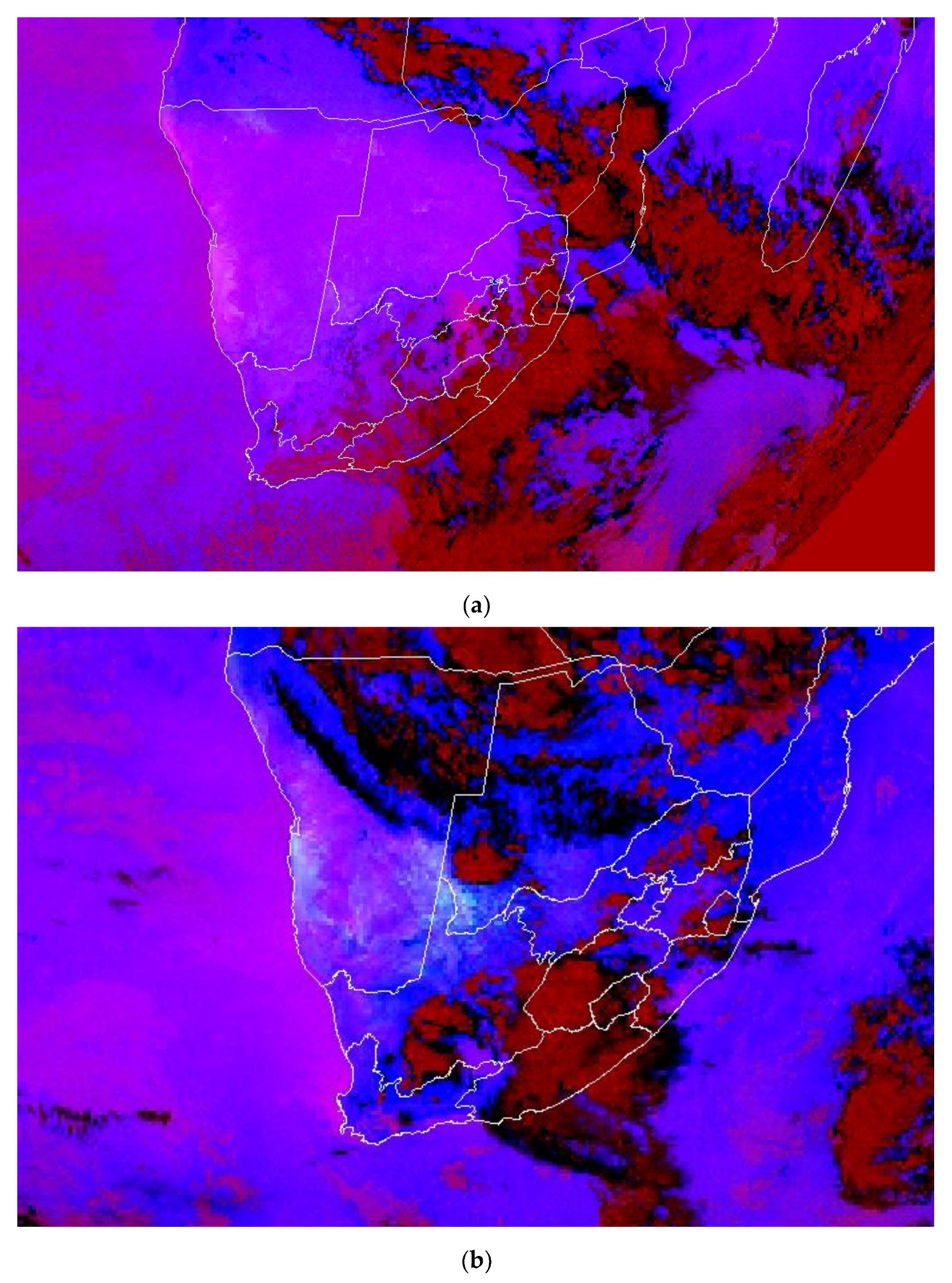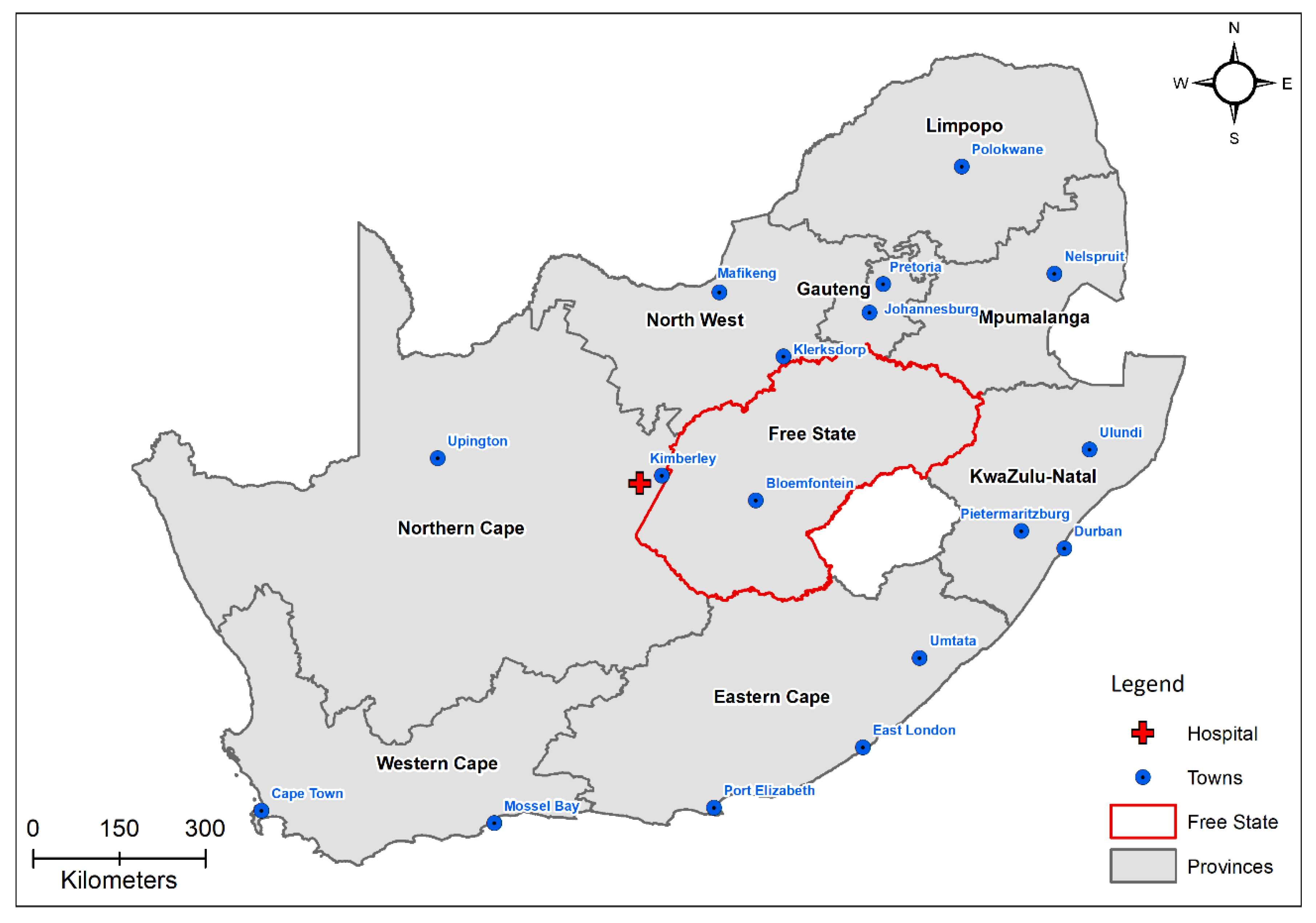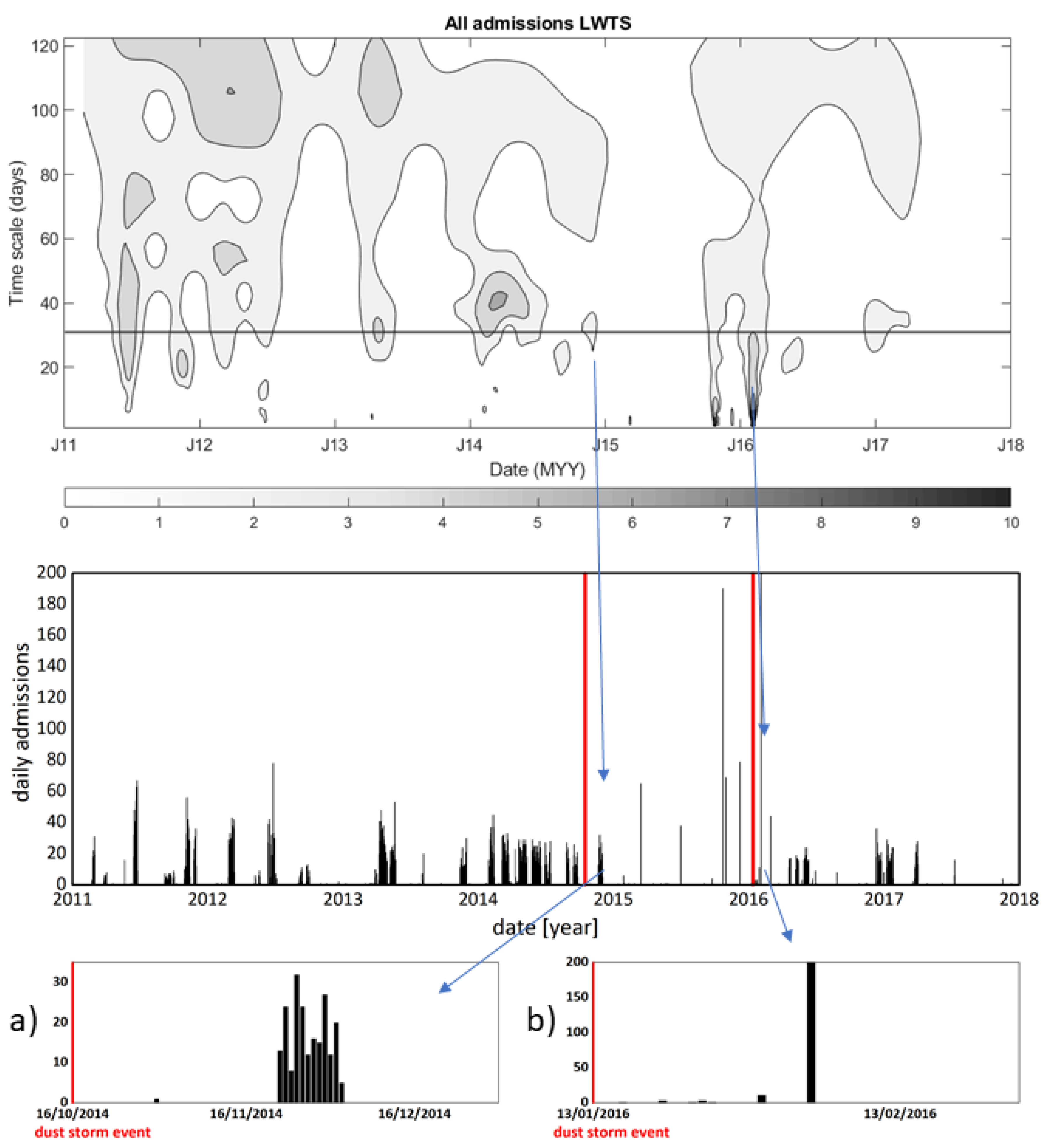Exploring Meteorological Conditions and Human Health Impacts during Two Dust Storm Events in Northern Cape Province, South Africa: Findings and Lessons Learnt
Abstract
:1. Introduction
2. Materials and Methods
2.1. Study Setting and Design
2.2. Hospital Admissions Data
2.3. Meteorological Data
2.4. Statistical Analyses
3. Results
3.1. Hospital Data Description
3.2. Findings of the Wavelet Transform Analyses
4. Discussion
5. Conclusions
Author Contributions
Funding
Institutional Review Board Statement
Informed Consent Statement
Data Availability Statement
Acknowledgments
Conflicts of Interest
Appendix A



| Respiratory Diseases and Symptoms | Cardiovascular Diseases | Motor Vehicle Accidents | Eye Irritation |
|---|---|---|---|
| Lower Respiratory Tract Infection (LRTI) Upper Respiratory Tract Infection (URTI) Chronic Obstructive Pulmonary Disease (COPD) Pulmonary TB Acute asthma Chronic asthma Asthma Tightness in the chest Bilateral pneumonia Pneumonia Emphysema Bronchitis Bronchiectasis Breathlessness Shortness of breath Wheeze Cough (wet, dry, acute, and chronic) Pleural effusion Chest pain Tuberculosis Influenza Bronchospasm Destructive lung disease Lung cancer Pulmonary oedema Pulmonary embolism | Cardiogenic shock Pericarditis Aortic Aneurism Pulmonary stenosis Cardiomegaly Cardiomyopathy Arrhythmia Mitral valve stenosis Peripheral vascular disease Coronary artery disease Angina Myocardial infarction Stroke Heart failure Hypertensive heart failure Rheumatic heart failure Cardiomyopathy Heart murmurs Congenital heart failure Valvular heart disease Carditis aortic aneurism Peripheral artery disease Thromboembolic dieses Congestive cardiac failure (CCF) Cerebrovascular accident (CVA) Atherosclerosis High blood pressure Hypertension High cholesterol/cholesterol Deep Vein Thrombosis/Venous thrombosis/DVT | Car accident Motor vehicle accident Motor accident injury Motorcycle accident | Red eye Eye irritation Painful eyes Foreign particles in the eyes Eye allergy Conjunctivitis |
References
- Baghbanan, P.; Ghavidel, Y.; Farajzadeh, M. Spatial analysis of spring dust storms hazard in Iran. Theory Appl. Clim. 2020, 139, 1447–1457. [Google Scholar] [CrossRef]
- Tong, D.Q.; Wang, J.X.L.; Gill, T.E.; Wang, B. Intensified dust storm activity and Valley fever infection in the southwestern United States. Geophys. Res. Lett. 2017, 44, 4304–4312. [Google Scholar] [CrossRef] [PubMed] [Green Version]
- Wang, X.; Dong, Z.; Zhang, J.; Liu, L. Modern dust storms in China: An overview. J. Arid. Environ. 2004, 58, 559–574. [Google Scholar] [CrossRef]
- Schweitzer, M.D.; Calzadilla, A.S.; Salamo, O.; Sharifi, A.; Kumar, N.; Holt, G.; Campos, M.; Mirsaeidi, M. Lung health in era of climate change and dust storms. Environ. Res. 2018, 163, 36–42. [Google Scholar] [CrossRef] [PubMed]
- Gross, J.E.; Carlos, W.G.; Dela Cruz, C.S.; Harber, P.; Jamil, S. Sand and dust storms: Acute exposure and threats to respiratory health. Am. J. Respir. Crit. Care Med. 2018, 198, 13–14. [Google Scholar] [CrossRef]
- Bekiswa, S.O. Master’s Thesis, Department of Environmental and Geographical Science, University of Cape Town, Cape Town, South Africa, 2018. Available online: https://open.uct.ac.za/handle/11427/31241 (accessed on 20 January 2022).
- Griffin, D.W. Atmospheric movement of microorganism in clouds of desert dust and implications for human health. Clin. Microbiol. Rev. 2007, 20, 459–477. [Google Scholar] [CrossRef] [Green Version]
- Goudie, A.S. Dust Storms and Human Health. In Extreme Weather Events and Human Health; Akhtar, R., Ed.; Springer International Publishing: Berlin/Heidelberg, Germany, 2020. [Google Scholar] [CrossRef]
- EUMETSAT. Dust in the Free State (South Africa). 2013. Available online: https://www.eumetsat.int/website/home/Images/ImageLibrary/DAT_2091101.html (accessed on 20 January 2022).
- NASA Earth Observatory. Dust Storm in Southern Africa. 2019. Available online: https://earthobservatory.nasa.gov/images/145659/dust-storm-in-southern-africa (accessed on 20 January 2022).
- IOL. Sandstorms Sweep through Social Media. 2014. Available online: https://www.iol.co.za/news/south-africa/northern-cape/sandstorms-sweep-through-social-media-1766400 (accessed on 20 January 2022).
- Two OV News. Pictures from the Epic Free State Sandstorm. 2016. Available online: https://www.2oceansvibe.com/2016/01/14/pics-from-the-epic-free-state-sandstorm-yesterday-gallery/; https://www.news24.com/news24/travel/pics-epic-free-state-sandstorm-will-literally-scratch-at-your-eyes-20160115 (accessed on 20 January 2022).
- Yang, C.Y.; Chen, Y.S.; Chiu, H.F.; Goggins, W.B. Effects of Asian dust storm events on daily stroke admissions in Taipei, Taiwan. Environ. Res. 2005, 99, 79–84. [Google Scholar] [CrossRef]
- Samoli, E.; Kougea, E.; Kassomenos, P.; Analitis, A.; Katsouyanni, K. Does the presence of desert dust modify the effect of PM10 on mortality in Athens, Greece? Sci. Total Environ. 2011, 1, 2049–2054. [Google Scholar] [CrossRef]
- Bell, M.L.; Levy, J.K.; Lin, Z. The effect of sandstorms and air pollution on cause-specific hospital admissions in Taipei, Taiwan. Occup. Environ. Med. 2008, 65, 104–111. [Google Scholar] [CrossRef]
- Stein-Zweers, D.; Veefkind, P. OMI/Aura Multiwavelength Aerosol Optical Depth and Single Scattering Albedo L3 1 Day Best Pixel in 0.25 degree x 0.25 degree V3, NASA Goddard Space Flight Center, Goddard Earth Sciences Data and Information Services Center (GES DISC); NASA Goddard Space Flight Center, Goddard Earth Sciences Data and Information Services Center (GES DISC): Greenbelt, MD, USA, 2012. [CrossRef]
- Platnick, S.; Hubanks, P.; Meyer, K.; King, M.D. MODIS Atmosphere L3 Monthly Product (08_L3). NASA MODIS Adaptive Processing System, Goddard Space Flight Center. 2015. Available online: https://doi.org/10.5067/MODIS/MOD08_M3.006 (accessed on 20 January 2022).
- Gasparrini, A.; Leone, M. Attributable risk from distributed lag models. BMC Med. Res. Method 2014, 14, 55. [Google Scholar] [CrossRef] [Green Version]
- Kapwata, T.; Wright, C.Y.; du Preez, D.J.; Kunene, Z.; Mathee, A.; Ikeda, T.; Landman, W.; Maharaj, R.; Sweijd, N.; Minakawa, N.; et al. Exploring rural hospital admissions for diarrhoeal disease, malaria, pneumonia, and asthma in relation to temperature, rainfall and air pollution using wavelet transform analysis. Sci. Total Environ. 2021, 791, 148307. [Google Scholar] [CrossRef] [PubMed]
- Wilczok, E. New Uncertainty Principles for the Continuous Gabor Transform and the Continuous Wavelet Transform. Doc. Math. 2000, 5, 207–226. Available online: https://eudml.org/doc/48549 (accessed on 20 January 2022).
- Torrence, C.; Compo, G.P. A Practical Guide to Wavelet Analysis. Bull. Am. Meteorol. Soc. 1998, 79, 61–78. [Google Scholar] [CrossRef] [Green Version]
- Morlet, J. Sampling Theory and Wave Propagation. In Issues in Acoustic Signal—Image Processing and Recognition; Chen, C.H., Ed.; NATO ASI Series (Series F: Computer and System Sciences); Springer: Berlin/Heidelberg, Germany, 1983; Volume 1. [Google Scholar] [CrossRef]
- Grossmann, A.; Morlet, J. Decomposition of Hardy Functions into Square Integrable Wavelets of Constant Shape. SIAM J. Math. Anal. 1984, 15, 723–736. [Google Scholar] [CrossRef]
- Astaf’eva, N.M. Wavelet analysis: Basic theory and some applications. Phys.-Uspekhi. 1996, 39, 1085. [Google Scholar] [CrossRef]
- Addison, P.S. The Illustrated Wavelet Transform Handbook: Introductory Theory and Applications in Science, Engineering, Medicine and Finance, Napier University, Edinburgh, United Kingdom, 1st ed.; Napier University: Edinburgh, UK, 2002; Available online: https://www.routledge.com/The-Illustrated-Wavelet-Transform-Handbook-Introductory-Theory-and-Applications/Addison/p/book/9780367574000 (accessed on 20 January 2022).
- Goupillaud, P.; Grossmann, A.; Morlet, J. Cycle-octave and related transforms in seismic signal analysis. Geoexploration 1984, 23, 85–102. [Google Scholar] [CrossRef]
- Aguiar-Conraria, L.; Soares, M.J. The continuous wavelet transform: Moving beyond uni- and bi-variate analysis. J. Econ. Surv. 2014, 28, 344–375. [Google Scholar] [CrossRef]
- Godsmark, C.N.; Irlam, J.; van der Merwe, F.; New, M.; Rother, A. Priority focus areas for a sub-national response to climate change and health: A South African provincial case study. Environ. Intern. 2019, 122, 31–51. [Google Scholar] [CrossRef]
- Koscielny-Bunde, E.; Kantelhardt, J.W.; Braun, P.; Bunde, A.; Havlin, S. Long-term persistence and multifractality of river runoff records: Detrended fluctuation studies. J. Hydro. 2006, 322, 120–137. [Google Scholar] [CrossRef] [Green Version]
- Ma, Y.; Xiao, B.; Liu, C.; Zhao, Y.; Zheng, X. Association between Ambient Air Pollution and Emergency Room Visits for Respiratory Diseases in Spring Dust Storm Season in Lanzhou, China. Int. J. Environ. Res. Public Health 2016, 13, 613. [Google Scholar] [CrossRef]
- Hashizume, M.; Kim, Y.; Ng, C.F.S.; Chung, Y.; Madaniyazi, L.; Bell, M.L.; Guo, Y.L.; Kan, H.; Honda, Y.; Yi, S.-M. Health Effects of Asian Dust: A Systematic Review and Meta-Analysis. Environ. Health Perspect. 2020, 128, 66001. [Google Scholar] [CrossRef] [PubMed]
- Verster, T.; Fourie, E. The good, the bad and the ugly of South African fatal road accidents. S. Afr. J. Sci. 2008, 114, 63–69. [Google Scholar] [CrossRef]
- Tesfaye, M.; Sivakumar, V.; Botai, J.; Mengistu Tsidu, G. Aerosol climatology over South Africa based on 10 years of Multiangle Imaging Spectroradiometer (MISR) data. J. Geophys. Res. 2011, 116, D20216. [Google Scholar] [CrossRef] [Green Version]
- Swap, R.J.; Annegarn, H.J.; Suttles, J.T.; King, M.D.; Platnick, S.; Privette, J.L.; Scholes, R.J. Africa burning: A thematic analysis of the Southern African Regional Science Initiative (SAFARI 2000). J. Geophys. Res.-Atmos. 2003, 108, D13. [Google Scholar] [CrossRef]
- Horowitz, H.M.; Garland, R.M.; Thatcher, M.; Landman, W.A.; Dedekind, Z.; van der Merwe, J.; Engelbrecht, F.A. Evaluation of climate model aerosol seasonal and spatial variability over Africa using AERONET. Atmos. Chem. Phys. 2017, 17, 13999–14023. [Google Scholar] [CrossRef] [Green Version]
- Fu, Q.; Mo, Z.; Lyu, D.; Zhang, L.; Qin, Z.; Tang, Q.; Yin, H.; Xu, P.; Wu, L.; Lou, X. Air pollution and outpatient visits for conjunctivitis: A case-crossover study in Hangzhou, China. Environ. Pollut. 2017, 231, 1344–1350. [Google Scholar] [CrossRef]
- Szyszkowicz, M.; Kousha, T.; Castner, J. Air pollution and emergency department visits for conjunctivitis: A case-crossover study. Int. J. Occup. Med. Environ. Health 2016, 29, 381–393. [Google Scholar] [CrossRef]
- Tam, W.W.; Wong, T.W.; Wong, A.H.; Hui, D.S. Effect of dust storm events on daily emergency admissions for respiratory diseases. Respirology 2012, 17, 143–148. [Google Scholar] [CrossRef]
- Soleimani, Z.; Teymouri, P.; Boloorani, A.D.; Mesdaghinia, A.; Middleton, N.; Griffin, D.W. An overview of bioaerosol load and health impacts associated with dust storms: A focus on the Middle East. Atmos. Environ. 2020, 223, 117187. [Google Scholar] [CrossRef]
- Herrera-Molina, E.; Gill, T.E.; Ibarra-Mejia, G.; Jeon, S. Associations between Dust Exposure and Hospitalizations in El Paso, Texas, USA. Atmosphere 2021, 12, 1413. [Google Scholar] [CrossRef]
- Al-Taiar, A.; Thalib, L. Short-term effect of dust storms on the risk of mortality due to respiratory, cardiovascular and all-causes in Kuwait. Int. J. Biometeorol. 2014, 58, 69–77. [Google Scholar] [CrossRef] [PubMed]
- Wang, Y.C.; Lin, Y.K. Mortality associated with particulate concentration and Asian dust storms in Metropolitan Taipei. Atmos. Environ. 2015, 117, 32–40. [Google Scholar] [CrossRef]
- Shahsavani, A.; Tobías, A.; Querol, X.; Stafoggia, M.; Abdolshahnejad, M.; Mayvaneh, F.; Guo, Y.; Hadei, M.; Hashemi, S.S.; Khosravi, A.; et al. Short-term effects of particulate matter during desert and non-desert dust days on mortality in Iran. Environ. Int. 2020, 134, 105299. [Google Scholar] [CrossRef] [PubMed]
- Niang, I.; Ruppel, O.C. Africa. In Climate Change 2014: Impacts, Adaptation, and Vulnerability. Part B: Regional Aspects. Contribution of Working Group II to the Fifth Assessment Report of the Intergovernmental Panel on Climate Change; Barros, V.R., Ed.; Cambridge University Press: Cambridge, UK; New York, NY, USA, 2014; Available online: https://www.ipcc.ch/site/assets/uploads/2018/02/WGIIAR5-Chap22_FINAL.pdf (accessed on 20 January 2022).
- Daron, J.D. Regional Climate Messages: Southern Africa. CARIAA Adaptation at Scale in Semi-Arid Regions. Climate Systems Analysis Group. 2014. Available online: http://www.assar.uct.ac.za/sites/default/files/image_tool/images/138/RDS_reports/climate_messages/Southern%20Africa%20Climate%20Messages%20-%20Version%201%20-%20Regional%20Level.pdf (accessed on 20 January 2022).
- Donges, J.F.; Schleussner, C.F.; Siegmund, J.F.; Donner, R.V. Event coincidence analysis for quantifying statistical interrelationships between event time series. Eur. Phys. J. Spec. Top. 2016, 225, 471–487. [Google Scholar] [CrossRef] [Green Version]



| Variable | Frequency n | Frequency % | |
|---|---|---|---|
| Sex | Female | 3970 | 48 |
| Male | 4189 | 51 | |
| Missing | 25 | <1 | |
| Age (years) | 0–12 | 2054 | 25 |
| 13–33 | 2031 | 25 | |
| 34–51 | 2029 | 25 | |
| 52–89 | 1935 | 24 | |
| ≥90 | 84 | 1 | |
| Missing | 40 | <1 | |
| Four outcomes of interest | Respiratory diseases | 5248 | 65 |
| Cardiac diseases | 1645 | 20 | |
| Eye irritation | 444 | 5 | |
| Motor vehicle accident | 836 | 10 | |
| Total | 8184 | 100 |
| Dust Storm Event | Respiratory Diseases n | Cardiac Diseases n | Eye Irritation n |
|---|---|---|---|
| 16 October 2014 | 119 | 44 | 23 |
| 13 January 2016 | 197 | 63 | 31 |
Publisher’s Note: MDPI stays neutral with regard to jurisdictional claims in published maps and institutional affiliations. |
© 2022 by the authors. Licensee MDPI, Basel, Switzerland. This article is an open access article distributed under the terms and conditions of the Creative Commons Attribution (CC BY) license (https://creativecommons.org/licenses/by/4.0/).
Share and Cite
Nkosi, V.; Mathee, A.; Blesic, S.; Kapwata, T.; Kunene, Z.; du Preez, D.J.; Garland, R.; Wright, C.Y. Exploring Meteorological Conditions and Human Health Impacts during Two Dust Storm Events in Northern Cape Province, South Africa: Findings and Lessons Learnt. Atmosphere 2022, 13, 424. https://doi.org/10.3390/atmos13030424
Nkosi V, Mathee A, Blesic S, Kapwata T, Kunene Z, du Preez DJ, Garland R, Wright CY. Exploring Meteorological Conditions and Human Health Impacts during Two Dust Storm Events in Northern Cape Province, South Africa: Findings and Lessons Learnt. Atmosphere. 2022; 13(3):424. https://doi.org/10.3390/atmos13030424
Chicago/Turabian StyleNkosi, Vusumuzi, Angela Mathee, Suzana Blesic, Thandi Kapwata, Zamantimande Kunene, David Jean du Preez, Rebecca Garland, and Caradee Yael Wright. 2022. "Exploring Meteorological Conditions and Human Health Impacts during Two Dust Storm Events in Northern Cape Province, South Africa: Findings and Lessons Learnt" Atmosphere 13, no. 3: 424. https://doi.org/10.3390/atmos13030424
APA StyleNkosi, V., Mathee, A., Blesic, S., Kapwata, T., Kunene, Z., du Preez, D. J., Garland, R., & Wright, C. Y. (2022). Exploring Meteorological Conditions and Human Health Impacts during Two Dust Storm Events in Northern Cape Province, South Africa: Findings and Lessons Learnt. Atmosphere, 13(3), 424. https://doi.org/10.3390/atmos13030424







